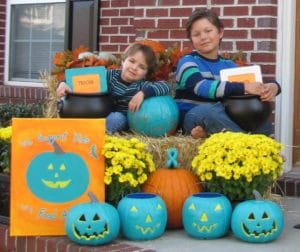Updated October 2019: Thanks to Becky Basalone, a mother-of-two and the creator of the Teak Pumpkin Project, Halloween is getting more teal and far less spooky for children with food allergies.
It was in the fall of 2012 that Basalone, the director of a local Tennessee food allergy support group, first had the bright idea of painting a pumpkin teal, the color of food allergy awareness, and handing out non-food items. What she didn’t know was that her teal pumpkin would become a nationwide symbol for Halloween food allergy awareness. In fact, it’s even taking off in Canada and Britain.
“As a parent, I pray that my actions have a positive impact on my children, but I had never imagined that this act of love would reach so far and impact so many,” says Basalone. “It is definitely accomplishing its mission of raising awareness and it has united the food allergy community to stand strong in support of our children.”
The folks at FARE (Food Allergy Research and Education) loved her “teal take” on Halloween and first got behind the idea for Halloween 2014, promoting the “Teal Pumpkin Project” to the media across the country. The teal pumpkin concept went viral on social media, reaching more than five million people on FARE’s Facebook page in that first year. It’s grown every year since, creating a new food allergy-friendly tradition. By 2018, several food allergy organizations were working together on the Project to heighten allergy awareness.
Allergic Living’s Courtney Born speaks to idea initiator Becky Basalone – learning how the Teal Pumpkin Project took off from her front porch.
The Teal Pumpkin Project that you started is all over social media and the media, helping to raise awareness for kids with food allergies this Halloween. How do you feel about that?
It’s amazing! We are overjoyed that we are helping so many families and communities by educating and empowering them.
 Becky Basalone's sons, Caden and Miles with their teal pumpkins.
Becky Basalone's sons, Caden and Miles with their teal pumpkins. What inspired you to start the Teal Pumpkin Project?
My youngest son has a history of anaphylaxis and in 2012 was diagnosed with life-threatening food allergies to peanut, tree nuts, cow’s milk, apple, and cinnamon as well as several food intolerances. My older son also has several food intolerances.
Halloween is scary because it is so food-focused. We still participated in traditional trick-or-treating and other Halloween activities but were very cautious and only visited a few homes in the neighborhood. My son is not allowed to touch the candy as it is dropped into the bag. If it is a candy item that we know contains his allergen, we simply say, “No thank you, he has food allergies,” or his brother will graciously accept the item in his bag instead depending on the product.
To connect more with local families, I started a food allergy support group, the Food Allergy Community of East Tennessee (FACET). Our group attended an allergy-friendly “Trunk or Treat” and my family painted a teal pumpkin as part of our trunk decor.
Afterwards, my older son placed the pumpkin on our front porch as we prepared to pass out treats to our neighborhood trick-or-treaters. We provided the option to choose from a bowl of candy treats or a bowl of safe, food-free “tricks” such as spider rings, googly eyes, and glow sticks.
We met several other families managing food allergies in our area, and the kids loved having the opportunity to choose a safe treat. It became a new Halloween tradition for us.
When our neighbors and trick-or-treaters approached our house on Halloween night, the kids would see the teal pumpkin and my son would proudly explain his food allergies to them. It became a source of pride and a way of starting the conversation. By the end of the night, the kids were more willing to dive into the bowl of food-free treats than the candy.
Did the project gain recognition in your neighborhood immediately, or did it take time to catch on?
The first year we launched the project, it sparked conversation and we recruited quite a few support group members. FACET grew to approximately 50 families by 2013 and we were a FARE-recognized support group when we decided to launch the Teal Pumpkin Project through our local support efforts. This one small act of placing the pumpkin on the porch was so empowering for families and their children that it just spread.
We passed out flyers in our neighborhood and then social media picked up on it. Support group leaders from across the nation were excited about the idea, and it ultimately caught the attention of FARE. They contacted us immediately asking if they could help promote the project in 2014. Of course we said, “YES!”
After all of the success of the campaign, what do you hope to see happen next in terms of food allergy awareness and festive events?
I just hope that this really helps to encourage inclusion for children with dietary limitations and restrictions. Medical conditions that limit children’s involvement in food-based activities can be detrimental to a child’s self-confidence and sense of self, so if we can improve that then I think we are doing a good job.
In no way do we want to exclude candy from the Halloween tradition. That is not our goal. We’d just like to see a safe alternative during food-based activities for these children.
Learn more about the Teal Pumpkin Project and download a free Teal Pumpkin Project printable sign.
Related:
Food-Free Halloween Fun: Teal Pumpkins, Stickers and More
Halloween Candy List: Allergy-Friendly Candies, Chocolate, and More
10 Outstanding Teal Pumpkins – and What Teal Means to the Designers






